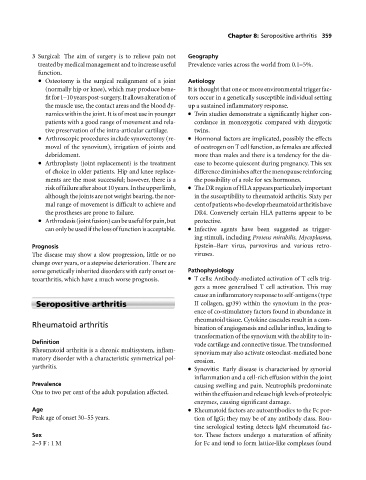Page 363 - Medicine and Surgery
P. 363
P1: KTX
BLUK007-08 BLUK007-Kendall May 12, 2005 19:48 Char Count= 0
Chapter 8: Seropositive arthritis 359
3 Surgical: The aim of surgery is to relieve pain not Geography
treated by medical management and to increase useful Prevalence varies across the world from 0.1–5%.
function.
Osteotomy is the surgical realignment of a joint Aetiology
(normally hip or knee), which may produce bene- It is thought that one or more environmental trigger fac-
fitfor1–10yearspost-surgery.Itallowsalterationof tors occur in a genetically susceptible individual setting
the muscle use, the contact areas and the blood dy- up a sustained inflammatory response.
namics within the joint. It is of most use in younger Twin studies demonstrate a significantly higher con-
patients with a good range of movement and rela- cordance in monozygotic compared with dizygotic
tive preservation of the intra-articular cartilage. twins.
Arthroscopic procedures include synovectomy (re- Hormonal factors are implicated, possibly the effects
moval of the synovium), irrigation of joints and of oestrogen on T cell function, as females are affected
debridement. more than males and there is a tendency for the dis-
Arthroplasty (joint replacement) is the treatment ease to become quiescent during pregnancy. This sex
of choice in older patients. Hip and knee replace- difference diminishes after the menopause reinforcing
ments are the most successful; however, there is a the possibility of a role for sex hormones.
riskoffailureafterabout10years.Intheupperlimb, The DR region of HLA appears particularly important
although the joints are not weight bearing, the nor- in the susceptibility to rheumatoid arthritis. Sixty per
mal range of movement is difficult to achieve and centofpatientswhodeveloprheumatoidarthritishave
the prostheses are prone to failure. DR4. Conversely certain HLA patterns appear to be
Arthrodesis(jointfusion)canbeusefulforpain,but protective.
can only be used if the loss of function is acceptable. Infective agents have been suggested as trigger-
ing stimuli, including Proteus mirabilis, Mycoplasma,
Prognosis Epstein–Barr virus, parvovirus and various retro-
The disease may show a slow progression, little or no viruses.
change over years, or a stepwise deterioration. There are
some genetically inherited disorders with early onset os- Pathophysiology
teoarthritis, which have a much worse prognosis. Tcells: Antibody-mediated activation of T cells trig-
gers a more generalised T cell activation. This may
cause an inflammatory response to self-antigens (type
Seropositive arthritis II collagen, gp39) within the synovium in the pres-
ence of co-stimulatory factors found in abundance in
rheumatoid tissue. Cytokine cascades result in a com-
Rheumatoid arthritis
bination of angiogenesis and cellular influx, leading to
transformation of the synovium with the ability to in-
Definition
vade cartilage and connective tissue. The transformed
Rheumatoid arthritis is a chronic multisystem, inflam-
synovium may also activate osteoclast-mediated bone
matory disorder with a characteristic symmetrical pol-
erosion.
yarthritis. Synovitis: Early disease is characterised by synovial
inflammation and a cell-rich effusion within the joint
Prevalence causing swelling and pain. Neutrophils predominate
One to two per cent of the adult population affected. withintheeffusionandreleasehighlevelsofproteolyic
enzymes, causing significant damage.
Age Rheumatoid factors are autoantibodies to the Fc por-
Peak age of onset 30–55 years. tion of IgG; they may be of any antibody class. Rou-
tine serological testing detects IgM rheumatoid fac-
Sex tor. These factors undergo a maturation of affinity
2–3 F : 1 M for Fc and tend to form lattice-like complexes found

